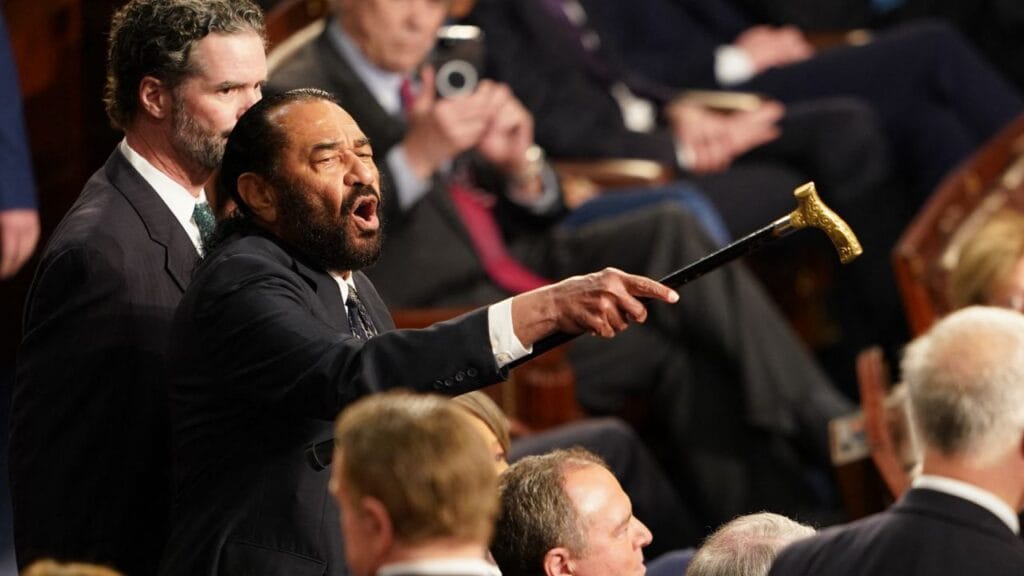Ten Democratic lawmakers sided with House Republicans on Thursday to censure Rep. Al Green for disrupting President Donald Trump’s recent address to Congress. This formal rebuke of the Texas Democrat underscores divisions within his party over how members should respond to the president’s remarks.
As Democrats navigate their role in Washington, they struggle to unify their message against Trump’s administration. The disagreement was evident on Tuesday night when some Democrats protested openly by walking out, holding signs, or boycotting the speech. Others, following leadership advice, chose restraint, fearing Republicans would exploit their actions for political gain.
Censure in Congress:
Censure, once a rare action in the House, has become more common in recent years. While it does not impose direct penalties, it serves as a serious reprimand. With a 224-198 vote, lawmakers approved the measure against Green, with the congressman himself and freshman Democrat Rep. Shomari Figures voting “present.”

Following the vote, Speaker Mike Johnson called for Green’s formal censure. In response, Green led a group of Democrats in singing “We Shall Overcome” on the House floor, prompting outrage from some Republicans. Johnson then ordered a recess to restore order.
Who Were the Democrats That Voted with Republicans?
The ten Democrats who supported the censure included:
- Ami Bera (California)
- Ed Case (Hawaii)
- Jim Costa (California)
- Laura Gillen (New York)
- Jim Himes (Connecticut)
- Chrissy Houlahan (Pennsylvania)
- Marcy Kaptur (Ohio)
- Jared Moskowitz (Florida)
- Marie Gluesenkamp Perez (Washington)
- Tom Suozzi (New York)
These lawmakers, mostly moderates, belong to centrist groups such as the Blue Dog Coalition, the New Democrat Coalition, or the bipartisan Problem Solvers Caucus. Some represent competitive districts, including Kaptur, Suozzi, and Gluesenkamp Perez, whose constituencies backed Trump in the last election.
Divisions Within the Democratic Party
Many Democrats expected unity against the censure but were surprised by the number who joined Republicans. Some lawmakers expressed frustration, arguing that Green’s protest had drawn attention away from critical issues, such as Trump’s plan to dismantle the Department of Education.
“There’s real anger,” said one Democratic lawmaker anonymously. “Leadership made it clear—we needed to maintain composure. Instead, Green’s actions dominated the headlines.” Another member questioned why Democrats weren’t showing a united front: “We should be on the same team.”
House Minority Leader Hakeem Jeffries clarified that there was no official party directive on the vote. “Members made their decisions based on their districts and what they believed was right,” he told reporters.
Green’s Response to the Censure
Speaking after the vote, Green remained defiant. “I have no anger in my heart,” he said on the House floor. The Texas congressman, 77, had interrupted Trump’s speech on Tuesday, prompting Speaker Johnson to remove him from the chamber.
On Wednesday, Green told reporters he accepted the consequences and would do it again. His protest was focused on Medicaid, which he believes is under threat from Republican budget cuts.
“I have no ill will toward the Speaker or those who escorted me out,” Green said. “I disrupted because the president claimed a mandate he does not have—to cut Medicaid.”
Republican Response and Future Consequences
Speaker Mike Johnson denounced Green’s actions as “shameful and egregious,” arguing they disrespected Congress. “He deliberately violated House rules, and censure is the appropriate response,” Johnson wrote in a post on X.
Conservative lawmakers are now pushing to strip Green of his committee assignments. The House Freedom Caucus is expected to introduce this measure next week.
The Bigger Picture
The censure of Rep. Al Green highlights broader tensions within the Democratic Party over how to confront Trump and his policies. While some favor bold protests, others argue for a more measured approach. The ten Democrats who joined Republicans in censuring Green may have prioritized party unity—or political survival in their swing districts.
As the debate continues, one thing is clear: The battle over how Democrats should oppose Trump is far from settled.




